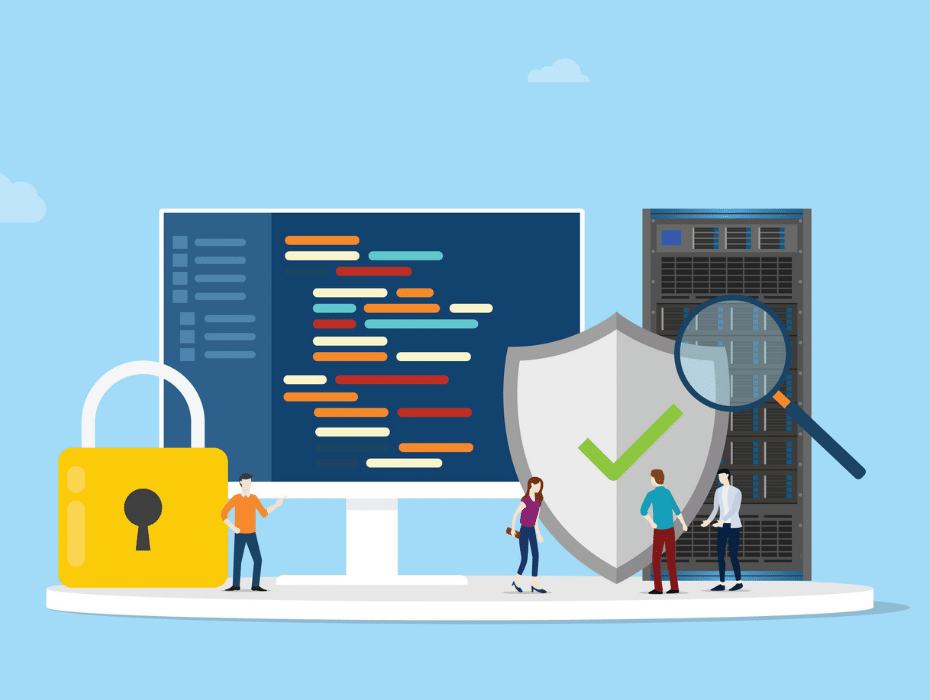Security has always been top-of-the-list for businesses across the world, but the digital transformation that’s happened over the past few years has really shifted the way we view our network security.
This is particularly true of the shift to remote work, where employees can work from anywhere—on any device and any connection. All the data and usual applications have moved to cloud environments, making the question of security a slightly more complex one. How can you implement a solid security strategy, while giving the whole team secure access?
⭐ What is a composable enterprise? ⭐
APIs and low-code/no-code solutions are the future of cloud technologies. But what does that mean? Here’s everything you need to know.
The answer? By implementing a zero trust security model. Unlike on-premises, there’s a greater need to protect sensitive digital information, as it can easily be hacked or exposed to malware. If businesses want to protect themselves online, they need to define strong network perimeters and security postures, and that’s where the zero trust model comes in.
What is the zero trust model?
Coined by John Kindervag of Forrester Research, the zero trust security model is a framework that secures all your business apps and data in the cloud. The zero trust model is:
- Based on the principle that no user can entirely be trusted, although it may sound a little harsh, it’s only a “model”. Zero trust architecture can be adapted to suit your needs, and many businesses set up certain permissions and network access codes that can only be used by specific employees.
- It’s all about protecting against vulnerabilities and providing a secure roadmap for your organization to work by, even for years to come.

Though it’ll probably need to be tweaked every couple of years, it’s one of the best security solutions for those working remotely or globally. It means incorporating a range of security measures based on the premise of Kindervag’s framework—this could be anything from adaptive authentication and access controls to ways in which you protect your digital assets.
How does zero trust work?
The zero trust approach is pinned on principles set forward by the National Institute of Standards and Technology (NIST) and includes:
- Regular and consistent verification: you should always verify access for resources and data across all endpoints, drawing up a strict access management policy
- Limit the damage done: you should always seek to recover your systems and data as soon as you’ve been breached or attacked
- Automate data collection: automation is key for getting information from your team’s IT stack in cases where a breach or security threat has been exposed (you can then work quickly to recover it).
Stay informed with RingCentral
Zero-trust security architecture hinges explicitly on the idea of “trust no user”. Unlike traditional security information and event management (SIEM) systems that trusted the user once they gained access, zero trust models continue to monitor and verify whether a user has specific rights and access to certain controls.
It won’t just allow users to sign in with a “saved password or code”, even if they’ve done so before — they’ll always have to go through multi-factor authentication and various security measures before being granted access.
When implementing a zero trust model, a wide range of technologies are used to “proof” your business digitally and protect your ecosystem from online threats. This includes things like authentication, identity verification, real-time access updates, email security, and the safety of endpoints before reaching end-users, ensuring a more enjoyable user experience (as the application will be free from security threats).

The whole premise of “trust no user” means you’ll need to consistently verify access requests and who can access exactly what, from least-privilege access to the highest levels of authority. To do this successfully, you’ll need real-time visibility into user and employee data and their access controls, including things like:
- Their user identity and credentials
- How many privileges and access points are they allowed to dip into?
- Their regular network and connection patterns and whether they use a VPN (if you notice an abrupt change, this could be the sign of data breaches or hacking, so take action first)
- Their geolocation
- The security of each of your (and your employees) verification protocols. (Is their device up to date?)
- The types of business applications they have on their device
- Any suspicious activity that goes against normal behaviors or routines
As well as routinely assessing your users and employees, you should also be checking up on your overall infrastructure from time to time. This will help you identify any gaps in security or attack surfaces where a breach is possible. As soon as you’ve noticed these things, work fast to patch them up to prevent a cyberattack.
Benefits of using a zero trust security model
Following a zero trust model and implementing security policies is a simple way to protect your business from digital threats, as well as control workloads in your data center. This is especially important if your business has many different cloud environments, as it can sometimes be difficult to keep track of and manage everyone.
Advantageous for businesses both big and small, we’ve listed some of the most notable benefits of using a zero trust security model.
1. Cuts down on risk and secures your business
Since the whole idea of the zero trust model is founded on the idea of “you can’t trust any user”, it automatically assumes that apps and people accessing those apps can’t be trusted (at least not until they’re been verified for user access). Most often, businesses and corporate networks implement this idea into their systems through authentications, firewalls, and strict access controls.
It’s a no-brainer, but all this focus on consistent verification and “zero trust” greatly reduces risk within your business. No one will be allowed access unless they meet the given requirements, giving you greater control over your network. All assets are vetted and checked, helping you create baselines and reduce the chance of giving too many people access to the same app.
2. Provides greater visibility in remote and cloud environments
While remote and hybrid work brings many benefits, there’s always the struggle of “visibility”.
But why?
Managers and senior leaders often find themselves in a position where they’ve got to play “catch-up” with employees, chase after them, and remind them of what tasks they’re doing. With everything in the cloud, sometimes things can get a little messy.
Luckily, a zero trust security model gives you greater visibility in these environments, thanks to the verification process. Access to apps and projects is only ever given to employees once they’ve been verified, making it easier for you to track tasks and which team members are working on what. Even if the environment changes (for example, the employee starts to work in a coffee shop) all the access controls will stay the same.
3. Prevents data breaches
In theory, it might seem harsh. The whole idea of “see everyone and everything as a threat” isn’t exactly trusting of your employees, but it’s the only way you’re going to weed out and prevent hackers from breaching your network.
Of course, you know you trust your team, but on the off-chance that someone outside the system does get through, assuming this stance of “trust no one” will actually work in your favor.
Why is this?
- Since adequate verification and controls are required to access anything (and this is continuously updated) an attacker won’t be able to penetrate your network even if they tried.
- Your system will keep kicking them out (since they can’t be trusted or verified) so they won’t be able to steal any of your data or sensitive company information.
- The structure of the zero trust model is also built on one single and secure segmentation, meaning no lateral movement can take place by the attacker.
4. Complies with privacy initiatives
As well as giving your cybersecurity a boost, implementing a zero trust security model into your business will naturally keep you in line with standard compliance and privacy initiatives. You’re already following the NIST guidelines, so you’ll automatically comply with most standards and regulations.
Not only does this mean you’ll have fewer “breaches of privacy initiatives” in audits, but you’ll also be able to develop network perimeters around specific types of data, particularly those holding extra-sensitive information. Even if some kind of security breach does take place, your zero trust model will give you greater visibility on areas that need to be patched up and repaired.
How to implement a zero trust security model into your business
Implementing a zero trust security model will take a bit of time, but it’s well worth it. Although you can follow zero trust solution frameworks, you have to remember that your business is unique and has different needs and features than other businesses — so, make sure you adapt to it accordingly. Here’s how:
- One of the first things you’ll need to do is think about all the trust principles you want to implement. What resources, endpoints, and apps need to be protected? What needs strict security access?
- Once you’ve figured this out, draft up a plan on how you’re going to verify the identity of each of your users and team members. And remember, everything has to be done on a single part of network segmentation — this ensures that all access controls stay the same, even if the environment changes.
- The next stage of developing your zero trust strategy involves looking at your entire system’s infrastructure as a whole. As well as setting up security measures like firewalls and verification protocols, you want to make sure you don’t have any missing “security gaps” in your network. If you spot any that can easily be breached, patch them up ASAP. The only way you’ll be able to mitigate risks and limit the damage done (if an attacker gains entry to your system) is by identifying your weak spots and taking action. You’ll then want to extend all your security protocols and measures across all endpoints.
Updated Feb 02, 2025











